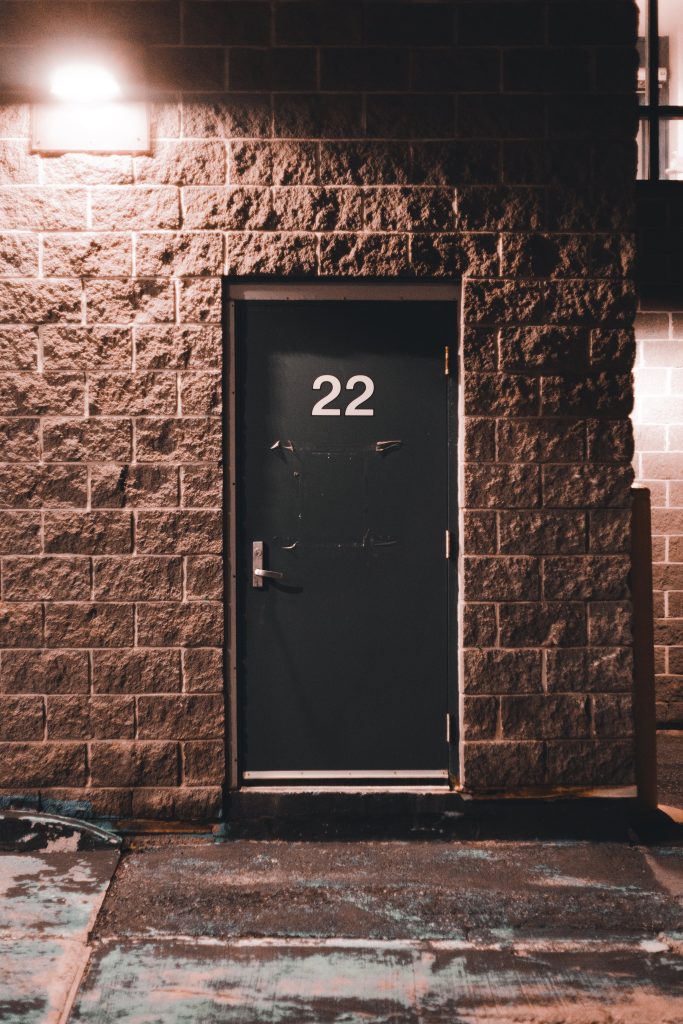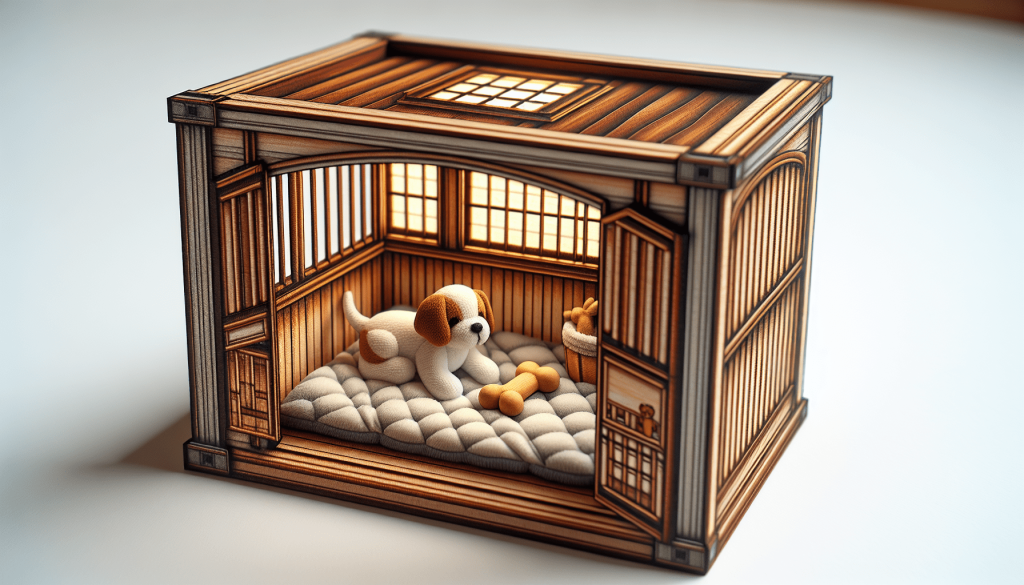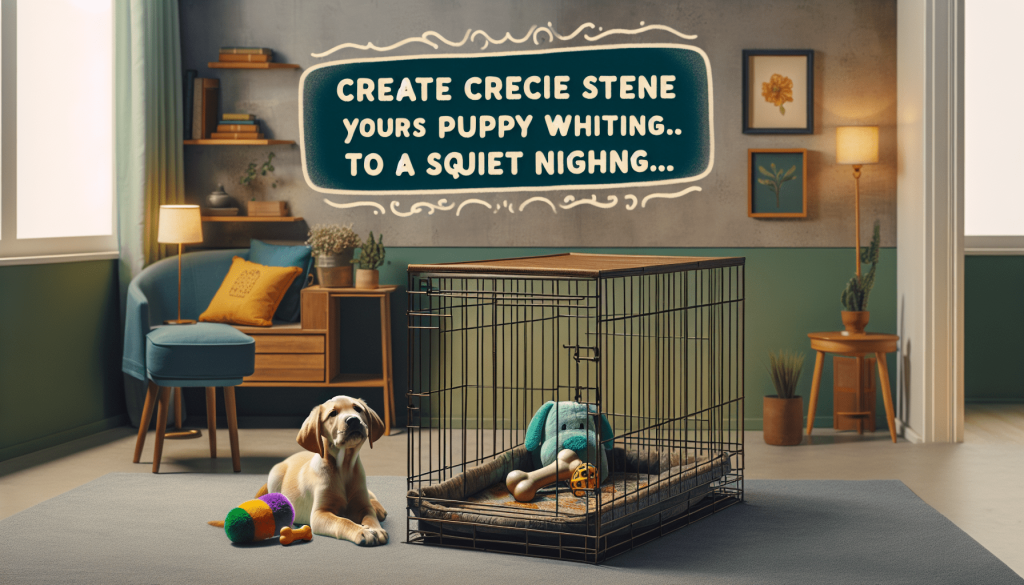Imagine coming home to a new furry addition to your family, a playful and adorable puppy! As you excitedly introduce them to their cozy crate, you quickly realize that their high-pitched whining is becoming a source of frustration for both you and your neighbors. But fear not, for this article will guide you through some helpful tips and techniques on how to stop a puppy from whining in the crate. With a little patience, consistency, and understanding, you’ll soon be enjoying peaceful moments with your pup without the constant whining.
Ensure a comfortable crate
Choose the right size crate
When crate training your puppy, it’s crucial to select the appropriate crate size. A crate that is too small can make your puppy feel restricted and uncomfortable, while a crate that is too large may encourage them to use one end for sleeping and the other for elimination. Aim for a crate that is just large enough for your puppy to stand up, turn around, and lie down comfortably.
Place soft bedding in the crate
To make the crate more comfortable and inviting, provide soft bedding for your puppy. This can include a cozy blanket or a comfortable dog bed. The bedding should be washable, as accidents may happen during the early stages of crate training. Having a soft and warm surface can help your puppy feel more secure and relaxed in their crate.
Make the crate inviting
To encourage your puppy to see the crate as a safe and welcoming space, make it more inviting. Add some toys or chew treats inside the crate to entice your puppy to explore and enter willingly. You can also drape a blanket over the crate to create a den-like atmosphere, which can make your puppy feel more secure. The goal is to make the crate a place your puppy wants to be, rather than a place of confinement.
Introduce the crate gradually
Introducing the crate gradually is important to prevent your puppy from associating it with negative experiences. Start by placing the crate in a common area of your home where your family spends time. Keep the crate door open and allow your puppy to explore it at their own pace. Use treats and praise to create positive associations with the crate as your puppy enters or investigates it. Gradually, begin encouraging your puppy to spend short periods of time in the crate with the door closed, gradually increasing the duration as they become more comfortable.
Create a positive association with the crate
Use treats and toys
To create a positive association with the crate, use treats and toys as rewards when your puppy enters or remains in the crate. You can offer a treat or a special chew toy that they only receive when in the crate. This motivates your puppy to view the crate as a place of enjoyment, rather than confinement.
Feed meals in the crate
Another effective way to create a positive association is to feed your puppy their meals inside the crate. By doing so, you are associating the crate with a rewarding and enjoyable experience. Place your puppy’s food bowl towards the back of the crate, so they need to move all the way inside to access their meal. This gradually reinforces the idea that the crate is a pleasant and safe space.
Provide praise and rewards
Whenever your puppy voluntarily enters the crate or stays inside without whining, make sure to provide plenty of verbal praise, petting, and additional rewards. This positive reinforcement strengthens the connection between good behavior and the crate. By consistently rewarding and praising your puppy, they will develop a positive association with the crate, making it more likely for them to settle down comfortably.
Make crate time enjoyable
Ensure that crate time is never associated with punishment or isolation. Make your puppy’s crate time enjoyable by giving them interactive toys, puzzle feeders, or treats that can keep them mentally stimulated and occupied. This not only distracts them from potential whining but also makes crate time more enjoyable and rewarding. Incorporating enjoyable activities can help foster a positive outlook on crate time for your puppy.

This image is property of images.pexels.com.
Establish a routine
Set a consistent schedule
To create a sense of predictability for your puppy, establish a consistent schedule for crate training. Designate specific times for meals, playtime, walks, and crate time. Consistency helps your puppy understand what is expected of them and reduces anxiety. By having a regular routine, your puppy will feel more secure and be less likely to whine in the crate.
Stick to a potty routine
Accidents can lead to discomfort or anxiety for your puppy, making them more likely to whine in the crate. Establishing a regular potty routine is crucial. Take your puppy outside to eliminate before placing them in the crate, and immediately after letting them out. This routine ensures that they have had the opportunity to relieve themselves and reduces the likelihood of accidents and subsequent whining.
Create a bedtime routine
A bedtime routine can help signal to your puppy that it is time to relax and settle down for the night. Establish a consistent routine that includes activities such as a final potty break, a brief play session, and some calming activities like gentle petting or cuddling. By consistently following this routine, your puppy will associate it with winding down for the night and be more inclined to settle in their crate without whining.
Use a calming routine before crating
Before placing your puppy in the crate, create a calming routine to help them relax. This can include dimming the lights, playing soft music or white noise, or using a calming pheromone diffuser. By incorporating these calming elements, you can help your puppy feel more relaxed and settled, reducing their likelihood of whining.
Address physical needs
Ensure sufficient exercise
To prevent restlessness or excess energy, ensure that your puppy receives sufficient exercise throughout the day. Taking your puppy for walks, engaging in play sessions, and providing mental stimulation through training or puzzle toys can help tire them out. A tired puppy is more likely to relax and settle in their crate without whining.
Provide mental stimulation
In addition to physical exercise, providing mental stimulation is equally important. Mental activities like training sessions, puzzle toys, or interactive games can tire your puppy’s mind and keep them mentally engaged. Mental stimulation can help alleviate boredom and prevent anxious behaviors such as whining in the crate.
Offer potty breaks before crating
Addressing your puppy’s physical needs, such as providing regular potty breaks, is essential for their overall comfort. Make sure to take your puppy outside to eliminate before placing them in the crate. By doing so, you reduce the likelihood of accidents and subsequent whining due to discomfort or a full bladder.
Manage food and water intake
Controlling your puppy’s food and water intake can help regulate their bathroom needs and prevent discomfort or accidents. Avoid feeding your puppy a large meal close to crate time, as it may increase the chances of needing to eliminate and potentially whining. Similarly, monitor their water intake, especially in the hours leading up to crate time, to minimize the likelihood of a full bladder.

This image is property of images.pexels.com.
Avoid reinforcing whining behavior
Do not reward whining
One of the most important rules in crate training is to avoid reinforcing whining behavior. If your puppy whines, resist the urge to immediately respond or let them out of the crate. Responding to whining can unintentionally reinforce the behavior, as your puppy learns that whining leads to attention or freedom. Instead, wait for a moment of quiet or calmness before rewarding or releasing your puppy.
Avoid letting the puppy out immediately
When your puppy whines in the crate, it’s important not to let them out immediately. Doing so can reinforce the whining behavior, as they learn that whining leads to being released from the crate. This can prolong the training process and create a pattern of whining whenever they want to be let out. Wait for a brief period of silence or calm before opening the crate door.
Ignore whining when unnecessary
If your puppy is safe, secure, and has already been let out recently, it is essential to ignore their whining when unnecessary. Whining can sometimes be a form of attention-seeking behavior, and by responding to it, you inadvertently reinforce it. By ignoring unnecessary whining, you teach your puppy that whining is not an effective strategy for gaining attention or being let out of the crate.
Use crate training techniques
Gradual crate training process
Crate training should be approached gradually to prevent overwhelming your puppy and to build positive associations. Start by introducing the crate in a positive manner, offering treats and praise for exploration and entry. Then, begin closing the crate door for short intervals, gradually increasing the time spent inside. This gradual approach helps your puppy adjust to the crate and reduces the likelihood of whining.
Only use the crate for short periods initially
During the initial stages of crate training, focus on short periods of crate time to prevent your puppy from becoming anxious or distressed. Begin with just a few minutes and gradually increase the duration over time. By starting with short intervals, your puppy will learn to associate the crate with positive experiences and feel more comfortable spending longer periods inside without whining.
Practice crate games
Crate games can be a fun and effective way to make the crate an enjoyable place for your puppy. Engage your puppy in games or activities inside the crate, such as hiding treats for them to find or tossing their favorite toys inside. This playful interaction helps your puppy associate the crate with positive experiences and distracts them from potential whining.
Increase crate time gradually
As your puppy becomes more comfortable and relaxed in the crate, gradually increase the duration of crate time. This gradual approach helps them build confidence and adapt to spending longer periods inside without becoming anxious or whining. Increase the duration by a few minutes each day, always rewarding and praising your puppy for their calm and quiet behavior.

This image is property of images.pexels.com.
Address underlying causes
Rule out medical issues
If your puppy’s whining persists despite following crate training techniques, it is essential to rule out any underlying medical issues. Schedule a visit with your veterinarian to ensure that there are no physical discomforts causing your puppy’s whining. Pain, an upset stomach, or other medical conditions can manifest as anxious behavior and whining in the crate.
Minimize separation anxiety
Separation anxiety is a common cause of whining in the crate. Gradually acclimate your puppy to being alone by using crate time as an opportunity for short absences. Start by leaving the room for a few seconds, gradually increasing the duration over time. This helps your puppy understand that you will always return, reducing their anxiety and potential whining.
Address fear or discomfort
Sometimes, whining in the crate can result from fear or discomfort. Identify any potential triggers or environmental factors that may be causing your puppy’s distress. For example, loud noises, excessive heat or cold, or a lack of ventilation can contribute to their anxiety. Addressing these factors, such as providing white noise or adjusting the temperature, can help alleviate their fears and minimize whining.
Stay calm and patient
Remain calm and composed
Crate training can be a challenging process at times, but it’s essential to remain calm and composed. Your puppy will pick up on your emotions, so it’s crucial to exude a sense of calmness and patience. Reacting with frustration or anger can create a negative association with the crate and potentially increase anxiety and whining.
Avoid frustration or anger
When your puppy whines in the crate, it’s important to avoid becoming frustrated or angry. Reacting with negative emotions can escalate the situation and make the whining worse. Instead, take deep breaths, remind yourself that crate training takes time, and focus on using positive reinforcement techniques to encourage desired behavior.
Practice positive reinforcement
Positive reinforcement is key to crate training success. Reward your puppy for calm and quiet behavior, offering treats, praise, and affection when they are settled in the crate without whining. By focusing on positive reinforcement, you create a positive and enjoyable crate experience for your puppy, encouraging them to settle without whining.
Be patient and consistent
Patience and consistency are crucial throughout the crate training process. Every puppy is unique, and some may take longer to adjust to the crate than others. Be patient with your puppy’s progress and avoid rushing the process. Consistency in your training methods and routines will help your puppy understand what is expected of them, leading to long-term success in crate training.

Seek professional guidance if needed
Consult a professional dog trainer
If your puppy continues to struggle with whining in the crate despite your best efforts, it may be beneficial to seek professional guidance. A professional dog trainer can provide personalized advice, tips, and techniques to help address your specific training and crate issues. They can observe your puppy’s behavior and provide expert guidance to ensure successful crate training.
Consider behaviorist consultation
In some cases, consulting with a certified animal behaviorist may be necessary. Behaviorists specialize in understanding and addressing complex behavioral issues in animals. If your puppy’s whining in the crate is severe, persistent, or accompanied by other problematic behaviors, a behaviorist can evaluate and develop a customized behavior modification plan to address the underlying causes.
Monitor progress and adjust strategies
Track progress and improvements
Keep track of your puppy’s progress throughout the crate training process. Monitor how long they can remain calm and quiet in the crate before whining occurs, as well as any improvements or setbacks. By documenting their progress, you can gain insight into what methods or strategies are most effective and adjust your training accordingly.
Modify techniques if necessary
Crate training is not a one-size-fits-all approach. If you find that certain techniques are not effective for your puppy, don’t be afraid to modify your training methods. Every puppy is unique, and what works for one may not work for another. Pay attention to your puppy’s individual needs and adapt your approach to ensure their comfort and success in crate training.
Continue to reinforce positive behavior
Even after your puppy has become comfortable in the crate and stops whining, it’s essential to continue reinforcing positive behavior. Provide occasional treats, praise, and rewards when your puppy voluntarily enters or settles in the crate without whining. This ongoing reinforcement helps solidify their positive association with the crate and encourages continued good behavior.
Ultimately, stopping a puppy from whining in the crate requires a combination of creating a comfortable environment, establishing positive associations, following a routine, addressing physical needs, avoiding reinforcing whining behavior, using effective crate training techniques, addressing underlying causes, staying calm and patient, seeking professional guidance if needed, and monitoring progress. By implementing these comprehensive strategies and approaches, you can help your puppy feel secure and content in their crate, leading to a peaceful and successful crate training experience. Remember, patience, consistency, and positive reinforcement are key to achieving long-term results.
